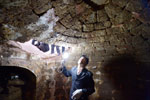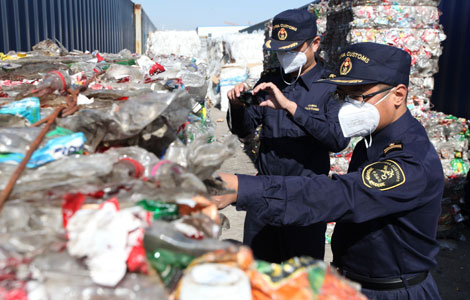A country at the opera
Updated: 2013-10-18 08:09
By Raymond Zhou (China Daily USA)
|
||||||||
As bicentennial celebrations of the opera world's twin titans build up to a crescendo, Raymond Zhou takes time to look back at how far China has come in embracing Wagner and Verdi in our musical life.
Wagner in China
The Bridal Chorus from Lohengrin reached China around the fin de siecle - so long ago that an ancient Chinese love poem was adopted for its lyrics. Of course it was limited to the elite who had exposure to Western culture.
For the most part, Richard Wagner did not receive advocacy in China by music makers, but rather by men of letters. Renowned poet Xu Zhimo published the following lines in Shanghai in 1923: "Is it the power of gods or magic / That whips up thunder and lightning / Storms and wails / Waves of desperate sea / Emotions, rage, generosity and melancholia / Are stirred up by strings and brass / Into a music drama inimitable / By Wagner, a pioneer in the sound and the heart." It's not among Xu's better-known works, but who else in China had enjoyed Wagner in a hall as he probably did while studying in England.
In the 1940s, some Chinese disciples of Nietzsche mentioned Wagner and his Ring in their treatises, but few understood what they were talking about. For the first three decades of New China, Wagner was non-existent even in the teachings of the nation's music academies because he was not one of those artists endorsed by Marxist authorities. When Yan Baoyu, a scholar educated in Germany and exposed to Wagner's music, was invited in 1980 to submit an entry on this giant of German culture to a new Chinese encyclopedia, he was allowed to touch on only Wagner's literary writings, but not his music.

In 1987, a Wagner biography in Chinese translation was published. Ten years later, the Chinese librettos of all his operas came out in a two-volume set, edited by Liu Xuefeng, who has since gone on to be a major apostle for Wagner in China. Chen Weizheng, a Chinese emigrant in Germany, has been attending the Bayreuth Festival for two decades, filing reports to the Chinese press and inviting Chinese enthusiasts to join him.
Wagner's music did not start seriously trickling into the Chinese mainland until the 1990s. The first complete opera by Wagner to find its way onto a Chinese stage was The Flying Dutchman, which was presented in Shanghai Grand Theater in 1999. Conductor Tang Muhai said he chose this opera because it has traces of Italian operas, which would make it more accessible to the Chinese audience.
Tang, who studied music in Munich and worked in Berlin, had a dream of staging all four operas of the Ring Cycle in China. But instead of fulfilling this impossible mission, he had to make do with more manageable projects of playing overtures and segments from Wagner's operas.
Where Tang failed, Yu Long, artistic director of the Beijing Music Festival, made it happen. In 2005, he brought Der Ring des Nibelungen to Beijing's Poly Theater. It was a four-night affair, produced by the Nuremberg State Theater with 240 performers and 12 containers of sets, props and costumes. "It was a milestone in China's music history," said Ke Hui, vice-president of the China branch of Richard Wagner Verband International, a fan club of Wagner lovers.
BMF followed up this coup with Tannhauser in 2008, also a German import, and this year, Parsifal. Beijing also saw a concert version of Tristan und Isolde in 2007.
In 2010, Shanghai Grand Theater staged two full cycles of the Ring, this time a production of the Cologne Opera under the baton of Markus Stenz. It was made possible by Chinese impresario Wu Jiatong who had been working in cross-cultural exchange, but mostly endeavors of a much smaller scale. The performances were broadcast live on local TV, but it was doubtful many were converted into Wagnerites. For most performances, including the 2005 Ring in Beijing, the audience would start thinning by half time.
Ke Hui reveals that China's Wagner Society has some 1,000 members. Sure, not every devotee to Wagner would register with his club, but he estimates that diehard fans in China are in the low thousands. The funny thing is, most of these people are not professional musicians, but white-collar workers who happen to be attracted to his music. They tend to be more knowledgeable than academics and would often help out theaters with promotional materials, libretto translation, etc. "Pros are usually intimidated by Wagner," he notes.
One pro who dares to pick up the gauntlet is soprano Wang Wei, who has in recent years taken on Elisabeth in Tannhauser and Brunnhilde in Die Walkure. Ke says Wang is still far behind the international standard of excellence for a Wagnerian, but she is turning a lot of heads - and ears. Asian singers often excel in Puccini and Mozart, but it is not easy to pull off the task of singing a major Wagner role.
The National Center for the Performing Arts, the egg-shaped national theater, since opening in late 2007, has embarked on an ambitious enterprise of producing lavish opera productions. Its first outing in Wagner is The Flying Dutchman - with such state-of-the-art stagecraft that people compared it to The Pirates of the Caribbean. This and the subsequent Lohengrin filled the house but divided critics. It is unclear how many neophytes were converted into Wagner aficionados.
With imports and self-productions, nine of the 10 "mature" operas in the Wagner canon have graced the Chinese stage, leaving only Die Meistersinger von Nurnberg. Of this year's offerings, Parsifal is a China premiere and is the most anticipated by many local Wagnerites. As for a self-production of the Ring, Ke says: "It's gonna happen within five years with NCPA. But they should probably do the tetralogy one opera at a time."
Verdi in China
To many Chinese, Verdi has been synonymous with La Traviata. For a long time, it was the only Verdi opera presented across China. On Dec 24, 1956, the China National Opera House staged an all-Chinese production at Tianqiao Theater in Beijing. It is considered the very first Western opera on a Chinese stage.
But that is inaccurate. According to Liu Shirong, an eminent music scholar, there are historical records that chronicle performances of Western music, including opera, in the Chinese cities of Shanghai and Harbin. For example, La Traviata was presented in Harbin in 1924, followed by Aida. These were all touring productions from Western countries, serving almost exclusively the expatriate communities in these Chinese cities. Liu was certain that Beijing and Tianjin, also with enclaves of Western residents, saw performances of Western opera as well, but records have been lost. And Hong Kong must have been exposed to it earlier than the rest of China, adds Liu.
For Chinese music devotees, i.e. those with good education and cosmopolitan outlooks, Verdi existed on the printed page and, sometimes, on the gramophone player. Stories of Western Opera, written by Xu Chi, a renowned writer, was one of several such titles popular in Shanghai in the 1930s-40s. Liu Shirong has clear memory of attending a fan club in Chengdu in 1944 when he heard a record of Un Ballo in Maschera. While a music student in Chongqing, he also went to a group meeting where the complete Il Trovatore was played, with explanatory guidance from a fellow student.

Still, the 1956 La Traviata was a milestone, not only because it featured all Chinese artists, but because it happened at all in a heavily ideological climate. The main reason Verdi could be performed at all in the early years of New China was that the Italian composer was embraced in the Soviet Union. A Soviet soprano was coaching at the China National Opera House, and to the amazement of everyone around, she proposed doing La Traviata rather than a Russian opera. "She had played the leading role in Moscow, and she showed us glamorous photos of it," recollects Liu.
Li Guangxi, who initiated the role of Alfredo Germont in New China, sang the opera from 1956 to 1963, and then after the "cultural revolution" (1966-76), from 1979 to 1984. Using the original French La dame aux Camelias as the Chinese title, the opera was so popular that during a 1962 run in Shanghai, it filled a 2,400-seat theater for 20 nights, with the ticket-buying line stretching for hundreds of meters along the street. The 1979 tour of Tianjin, saw the opera performed 39 times in a 2,300-seat theater.
La Traviata was also the first Western opera to be revived in post-"cultural revolution" China, later followed by Rigoletto, Il Trovatore and many of Verdi's middle-age work. But for the masses with little access to the occasional theatrical performance, the availability of the videodisk around 1990 was a watershed in raising the exposure to - and level of appreciation for - Verdi and other Western musicians. There are accounts of opera-curious youths bicycling across Beijing to attend screenings of the 1983 film version of La Traviata directed by Franco Zeffirelli and starring Domingo. Though using an informal venue with disregard to authorization, the run was said to be much longer than most blockbusters of today.
"In the old days, only China National Opera House was allowed to do Western operas," explains Liu. "But now anyone can produce one, and the first choice is usually a Verdi work. It is simply more popular with the public." Compared with Wagner, for example. Though there is no data, empirical evidence shows that Chinese music fans would prefer Verdi over Wagner, but those who love Wagner tend to be intensely loyal, something akin to "religious fervor" in the words of music critic Tang Ruofu. Some experts explain that the Chinese singing tradition of "one singing followed by three others" is reminiscent of the structure in a typical Verdi aria and cabaletta. That and the hummable vocal lines have made Verdi much beloved by a wider swath of China's music-loving society.
For those who want to check out the scores, some of Verdi's manuscripts are on display in the China National Museum, or they can go to NCPA for its extravagant productions. So far, it has done La Traviata, Un Ballo, Otello, Nabucco, Rigoletto and, in concert form, Aida. "Nobody beats NCPA in China in the scale of a production," says Li Cheng, an opera critic. "But it is a giant standing on the shoulder of previous generations." One of these pioneers is Qian Shijin, who presented the China premieres of several Verdi works in Shanghai.
Li cites spinto soprano He Hui as a major Chinese proponent for Verdi. After making rounds of the world's greatest opera houses, she returned to China in Un Ballo and Aida, wowing her home audience with superlative delivery of Verdian grandeur.
Contact the writer at raymondzhou@chinadaily.com.cn.
(China Daily USA 10/18/2013 page7)
Most Viewed
Editor's Picks

|

|

|

|

|

|
Today's Top News
US not budging on its arms restrictions on China
China's GDP rises 7.8% in Q3
China warns of emerging markets' slowing demand
Roche boosted by strong drug sales in US, China
IBM's China-driven slump sparks executive shakeup
Can cranberries catch on in China?
Asia-Pacific pays executives world's highest salaries
US debt deal a temporary fix
US Weekly

|

|













